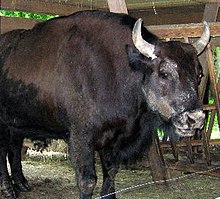Żubroń

The Żubroń [ ˈʒubrɔɲ ] ( Polish ) or Germanized Zubron is a hybrid of domestic cattle and wisent (Polish Żubr ). It is thus a counterpart to the North American Beefalo .
The first documented successful breeding comes from Leopold Walicki in 1847, earlier crosses may also have been successful. After the Second World War, several scientists considered using the Żubroń as a possible substitute for domestic cattle. The Żubroń turned out to be very resilient and almost immune to disease. In addition, it can be kept in very barren areas without any agricultural infrastructure. From 1958, the Polish Academy of Sciences continued to work with Żubroń herds in several field trials; the best known were those in Białowieża and Młodzikowo . During the first 16 years of the experiment, 71 young animals were born, including Filon on August 6, 1960 , the first Żubroń to be born from a Żubroń cow. The Żubroń had become a tough and cheap alternative to domestic cattle, and attempts continued into the late 1980s. The two famous research centers for the breed were Łękno (391 animals in total) and Popielno (121 animals). Limited trials were also carried out in the Askanija-Nova nature reserve in what was then the USSR .
However, fertility and profitability were not satisfactory. The attempts were canceled. Today the only remaining herd with only a few animals is in the Białowieża National Park .
Żubrońs are very heavy animals - bulls can reach 1200 kg and cows up to 810 kg. They are very strong, immune to most diseases and harsh weather. The male animals are sterile in the first generation , but the female are fertile and can reproduce with both parent species, i.e. domestic cattle or bison. The resulting male offspring are fertile.
Web links
- Brief information about Żubroń
- Brief description at messybeast.com (English)
- Page to Żubroń (Polish)
